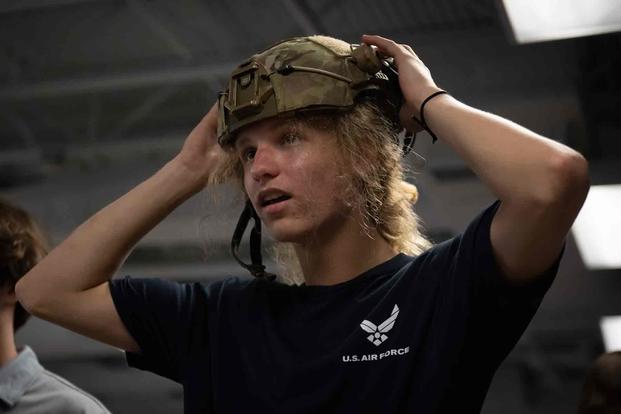AURORA, Colorado -- Last year, the Air Force saw the writing on the wall and announced a projected 10% shortfall in its active-duty recruiting goals -- a prediction that ultimately proved true, marking the first time since 1999 the service missed its mark.
But a lot can change in one year.
Brig. Gen. Christopher Amrhein, commander of the Air Force Recruiting Service, told reporters at the Air and Space Forces Association's Warfare Symposium Conference on Tuesday evening that the service is "cautiously optimistic" and has hit its recruiting goals each month since the start of the fiscal year in October.
"Looking ahead to the second half of fiscal '24, we continue to remain cautiously optimistic," Amrhein said. "We continue to make goal for [active-duty] Air Force and Space Force, and we are very close to the Air Force Reserve requirement."
He added that the Air Force is at about 101% of its month-to-month recruiting goals and has completely filled jobs for February, March and well into April.
Prior to missing its 2023 goals, the last time the Air Force did not reach 100% of its recruitment goal was 1999, according to the Air Force Recruiting Service. That was when Millenials -- who were born between 1981 and 1996 -- first began to reach the age of service. In 1979, the Air Force also missed its goals when Generation X began to become of age to serve, according to a 2002 research paper from Air University.
Now, all the services are working to recruit Gen Z -- defined as those born between 1997 and 2012.
That has been a challenge during the past few years as the U.S. has seen some of its lowest unemployment rates in decades and civilian employers are offering higher-paying jobs with better quality-of-life benefits. Added to that, the Pentagon has released studies showing that only 23% of American youth are eligible to serve due to being overweight, using drugs, or having mental or physical health problems.
The Air Force Recruiting Service has told Military.com in the past that less than 10% of the young population is interested in serving in the first place -- 50% can't even name all the military service branches.
To combat this, the Air Force Recruiting Service has been addressing a variety of the barriers to service that have existed for years, as well as unveiling incentives to airmen for bringing folks into the ranks.
These include offering medals and promotions for recruiting; streamlining the naturalization process so recruits can become citizens during basic military training; updating body composition standards to mirror the Defense Department's more forgiving requirements; reinstating the Enlisted College Loan Repayment Program; allowing certain tattoos on the hands and neck; and unveiling a new smartphone feature that allows airmen to send info on almost anyone to a recruiter.
Those policies, many started under Amrhein's predecessor, have brought previously disqualified Americans into the ranks, Amrhein said.
More than 600 referrals came from offering medals and promotions for recruiting, 200 of whom joined the ranks. That tattoo policy change brought in 176 new airmen. Updating body composition led to 2,000 recruits now qualifying for service with just one physical fitness test failure. Around 220 airmen qualified for college loan repayment, and the service estimates that 500 will be eligible each year.
Those numbers add up, especially because the 10% shortfall in the Air Force's recruiting goal equates to about 2,700 airmen.
Amrhein said one of the Air Force Recruiting Service's next major efforts is to try and wrangle those who drop out of the recruitment process due to long timelines in gathering, reviewing and correcting the medical paperwork that's required to join.
In fiscal 2023, around 8,800 applicants "walked away from the recruiting process because of medical processing timelines," he said. With a 70% waiver rate, on average, in the Air Force, that might have equated to more than 6,000 airmen who could have likely joined the ranks.
"If we can continue to work that piece, I think we can garner a great number of folks to join our aerospace forces," Amrhein said.
The Space Force, which is under the Department of the Air Force's recruiting umbrella, has had no issues meeting its recruiting goals in the past and is anticipated to hit it this year due, in part, to its small size.













